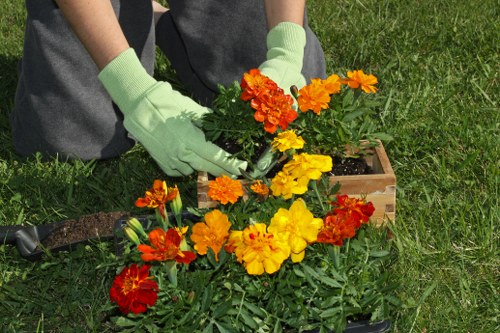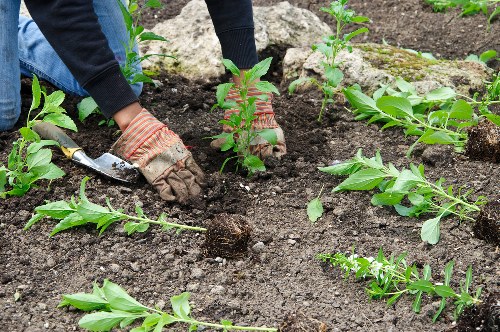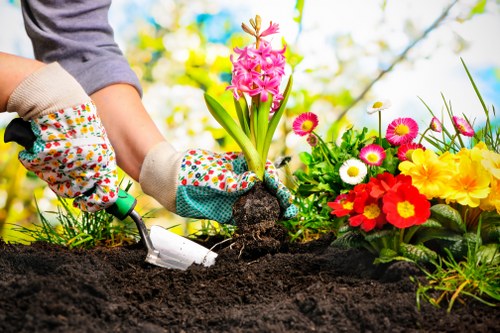Comprehensive Guide to Garden Clearance for Gardeners

Understanding Garden Clearance
Garden clearance is an essential service for maintaining the health and aesthetics of your outdoor space. Whether you're preparing for a new planting season or clearing out unwanted debris, professional garden clearance ensures that your garden remains a vibrant and functional area.
Effective garden clearance involves the removal of dead plants, fallen leaves, and other organic matter that can hinder plant growth. It also includes the disposal of larger items like old furniture, shed materials, and garden structures that are no longer in use.
For gardeners, regular garden clearance is crucial not only for maintaining the beauty of the garden but also for preventing the spread of pests and diseases. A well-maintained garden can thrive, providing a serene environment and a healthy ecosystem for various plant and animal species.

Benefits of Professional Garden Clearance
Hiring professionals for garden clearance offers numerous advantages. Firstly, it saves you time and effort, allowing you to focus on other aspects of gardening or personal activities. Professionals have the expertise and equipment to clear large or overgrown areas efficiently.
Additionally, professional garden clearance ensures that waste is disposed of responsibly. Many services recycle organic materials, reducing the environmental impact and promoting sustainable gardening practices.
Moreover, regular clearance by experts can enhance the overall health of your garden. By removing diseased plants and debris, you minimize the risk of infestations and promote healthier plant growth.

Steps Involved in Garden Clearance
Initial Assessment
The first step in garden clearance is conducting a thorough assessment of the area. Professionals evaluate the extent of the work needed, identifying key areas that require attention. This assessment helps in planning the most effective clearance strategy.
Planning and Strategy
Based on the initial assessment, a detailed plan is formulated. This plan outlines the specific tasks, timelines, and resources required for the clearance process. Proper planning ensures that the job is completed efficiently and within the stipulated time frame.
Execution
With the plan in place, the actual clearance begins. This involves removing unwanted plants, debris, and other materials. Specialized equipment may be used to tackle larger or more stubborn areas, ensuring a comprehensive clearance.

Essential Tools for Garden Clearance
Having the right tools is vital for effective garden clearance. Here are some essential tools used by professionals:
- Rakes and Hoes: For gathering leaves and debris.
- Pruners and Shears: To trim and remove dead or overgrown branches.
- Wheelbarrows: For transporting waste materials.
- Leaf Vacuums: To efficiently collect fallen leaves and small debris.
- Chainsaws: For cutting through thick branches and wood.

Environmental Considerations
When performing garden clearance, it's important to consider the environmental impact. Recycling and composting organic waste can reduce landfill usage and contribute to a healthier garden ecosystem.
Additionally, using eco-friendly disposal methods ensures that harmful chemicals or materials do not contaminate the soil and water sources. Sustainable practices in garden clearance are essential for long-term environmental health.
Implementing these practices not only benefits the environment but also enhances the overall quality and sustainability of your garden.

Cost Factors in Garden Clearance
The cost of garden clearance can vary based on several factors:
- Size of the Garden: Larger gardens require more time and resources, impacting the overall cost.
- Extent of Overgrowth: The more overgrown the garden is, the more labor-intensive the clearance process.
- Accessibility: Difficult-to-reach areas may require specialized equipment, increasing costs.
- Type of Waste: Certain types of waste, like wood or large debris, may incur additional disposal fees.
- Frequency of Service: Regular clearance services may offer discounts compared to one-time clearances.

Choosing the Right Garden Clearance Service
Selecting a reputable garden clearance service is crucial for ensuring quality work. Here are some tips to help you make the right choice:
- Check Reviews: Look for customer reviews and testimonials to gauge the reliability and quality of the service.
- Get Multiple Quotes: Comparing prices from different providers can help you find a competitive rate.
- Verify Qualifications: Ensure that the service has the necessary licenses and insurance.
- Ask About Procedures: Inquire about their clearance and disposal methods to ensure they align with your environmental values.
- Assess Experience: Experienced professionals are more likely to handle your garden clearance efficiently and effectively.

Safety Measures in Garden Clearance
Safety is paramount during garden clearance. Professionals adhere to strict safety protocols to prevent accidents and injuries. Here are some key safety measures:
- Proper Training: Staff are trained in the correct use of tools and equipment.
- Protective Gear: Wearing gloves, goggles, and other protective clothing minimizes the risk of injury.
- Equipment Maintenance: Regular maintenance of tools and machinery ensures they function safely.
- Clear Communication: Effective communication among team members prevents misunderstandings and accidents.
- Emergency Preparedness: Having first aid kits and emergency procedures in place is essential.

Seasonal Garden Clearance Tips
Different seasons require specific garden clearance approaches. Here are some tips for each season:
Spring Clearance
Remove winter debris and prepare the garden for new growth. Trim shrubs and prune trees to encourage healthy blooms.
Summer Clearance
Manage weed growth and maintain plant health through regular clearing and mulching.
Autumn Clearance
Rake fallen leaves and clear out dead plants to ready the garden for winter.
Winter Clearance
Protect delicate plants and structures from harsh weather. Perform any necessary clearance before the ground freezes.

DIY vs. Professional Garden Clearance
While DIY garden clearance can save money, it may not always be the best option. Here are some considerations:
- Time and Effort: DIY clearance requires significant time and physical effort, which may not be feasible for everyone.
- Expertise: Professionals have the experience to handle complex clearance tasks efficiently.
- Equipment: Access to specialized tools is often necessary for thorough clearance.
- Safety: Professional services prioritize safety, reducing the risk of accidents during clearance.
Ultimately, the choice between DIY and professional clearance depends on your specific needs, budget, and available resources.

Maintaining a Clear Garden
Once you've completed garden clearance, maintaining a clear and healthy garden requires ongoing effort. Here are some maintenance tips:
- Regular Weeding: Remove weeds promptly to prevent them from taking over.
- Pruning: Regularly trim and prune plants to encourage growth and prevent overgrowth.
- Mulching: Apply mulch to retain moisture and suppress weed growth.
- Composting: Compost organic waste to enrich the soil and reduce landfill waste.
- Seasonal Checks: Conduct seasonal inspections to address any issues promptly.

Choosing Eco-Friendly Clearance Options
Eco-friendly garden clearance options help preserve the environment while maintaining your garden. Here are some sustainable practices:
- Recycling: Recycle materials like metal, plastic, and glass whenever possible.
- Composting: Convert organic waste into compost to enrich your garden soil.
- Donate: Donate usable items like garden furniture or structures to local charities.
- Biodegradable Disposal: Use biodegradable methods for disposing of non-recyclable waste.
- Energy-Efficient Equipment: Opt for energy-efficient tools and machinery to reduce your carbon footprint.

Common Challenges in Garden Clearance
Garden clearance can present several challenges, including:
Overgrown Vegetation
Thick, overgrown plants can be difficult to remove and may require specialized equipment.
Large Debris
Handling and disposing of large debris like old furniture or structures can be labor-intensive.
Limited Accessibility
Areas that are hard to reach may complicate the clearance process and require creative solutions.
Weather Conditions
Adverse weather can delay the clearance process and make it more challenging to work effectively.

Benefits of Regular Garden Clearance
Maintaining a regular garden clearance schedule offers numerous benefits:
- Enhanced Aesthetics: A clean garden looks more attractive and inviting.
- Improved Plant Health: Removing dead and diseased plants promotes healthier growth.
- Reduced Pest Problems: Clearing debris eliminates hiding spots for pests.
- Increased Safety: Removing tripping hazards and overgrown vegetation ensures a safer environment.
- Environmental Benefits: Sustainable clearance practices support environmental conservation.

Final Thoughts on Garden Clearance
Garden clearance is a pivotal aspect of gardening that ensures your outdoor space remains healthy, beautiful, and functional. Whether you choose to undertake it yourself or hire professionals, regular clearance is key to a thriving garden.
Investing in quality garden clearance not only enhances the aesthetic appeal of your garden but also contributes to a sustainable environment. By following best practices and considering eco-friendly options, you can maintain a garden that is both beautiful and environmentally responsible.
Contact us today to schedule your professional garden clearance and take the first step towards a healthier, more vibrant garden.



